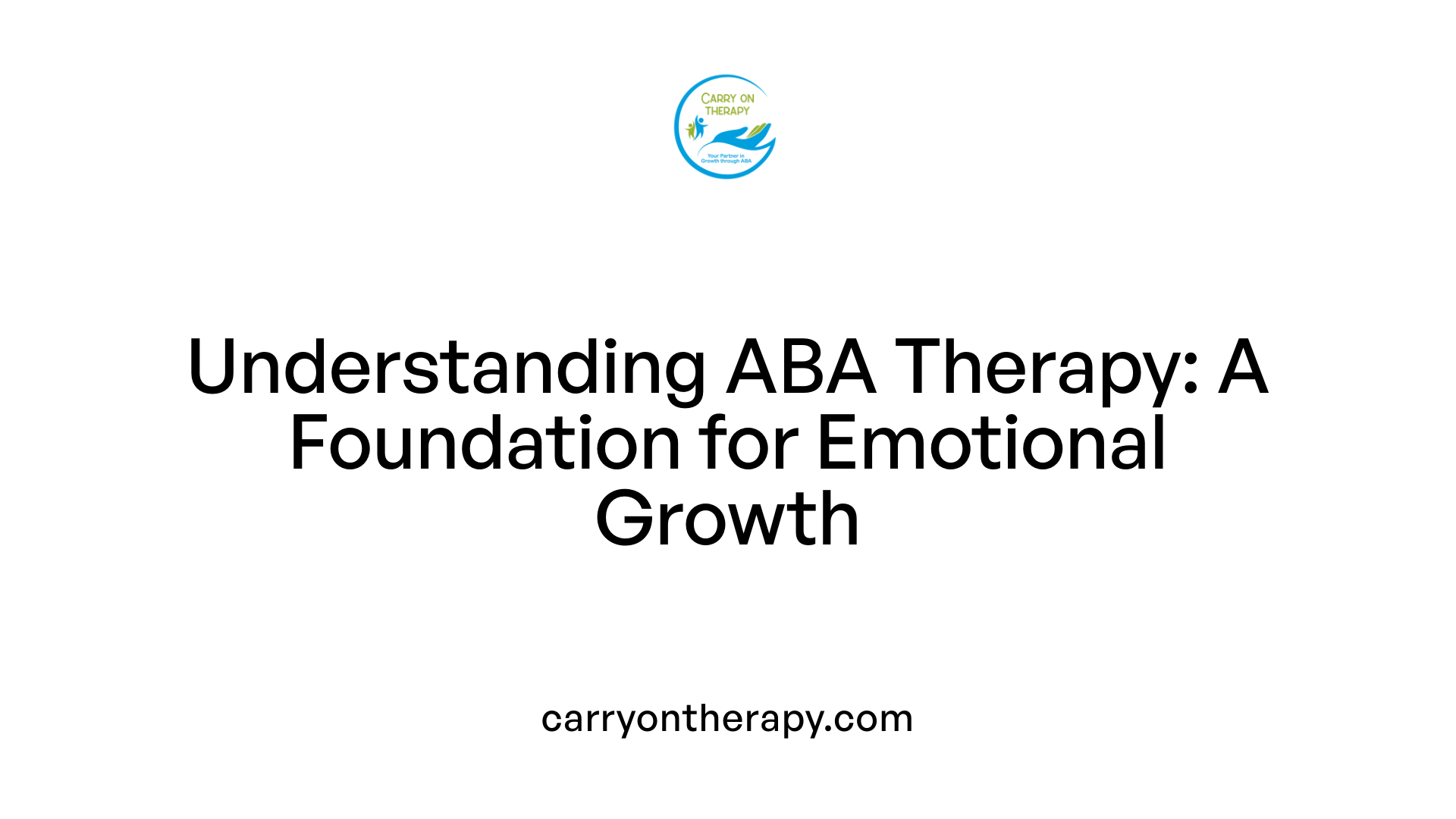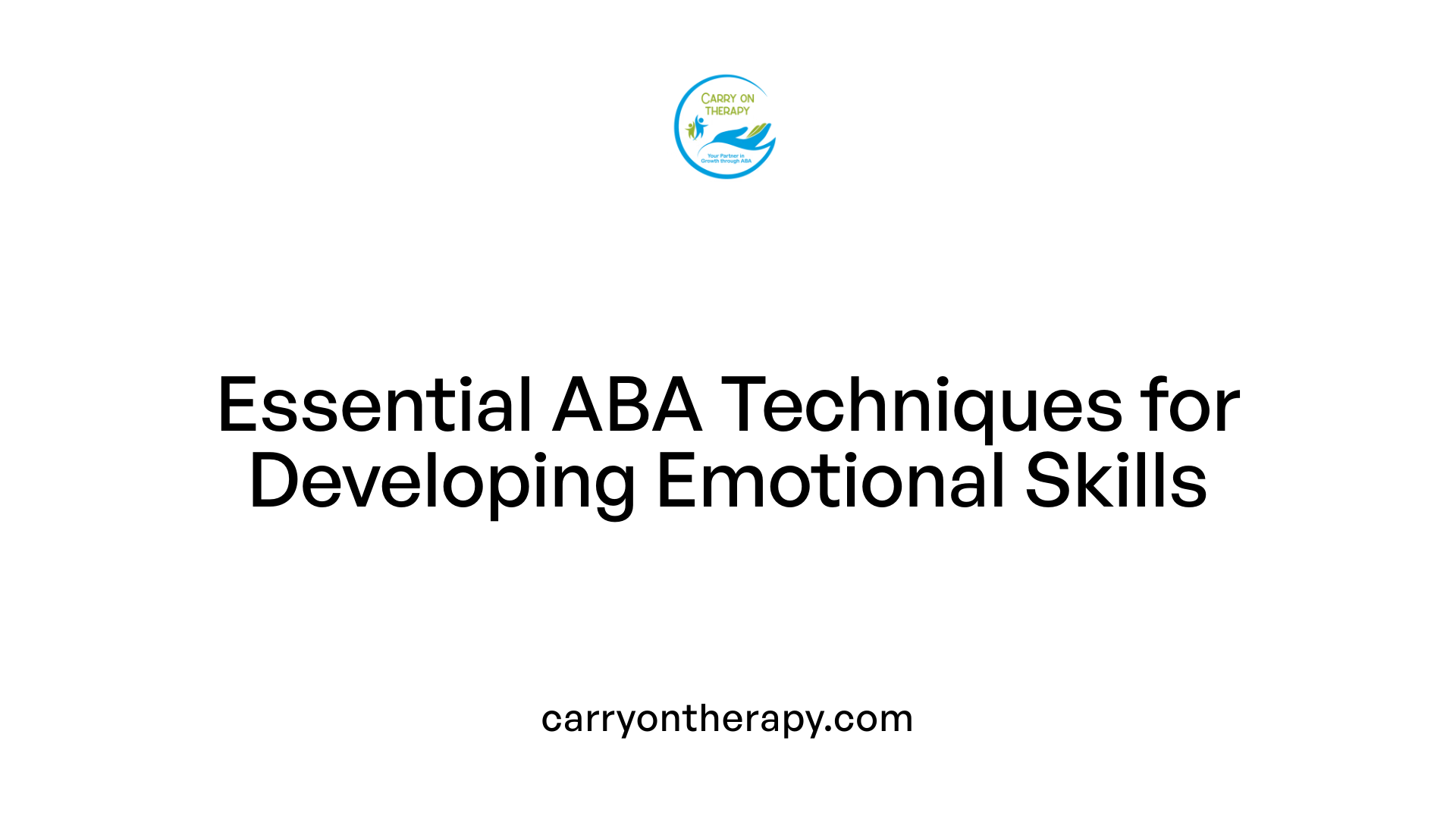The Importance of Addressing Emotional Regulation Through Therapy
How Therapy Enhances Emotional Control in Autism

Understanding Emotional Regulation in Autism Therapy
Emotional regulation is a critical area of focus in therapies designed for children with autism spectrum disorder (ASD). Addressing emotional regulation effectively can significantly improve a child's daily functioning, social interactions, and overall quality of life. Among the therapies available, Applied Behavior Analysis (ABA) stands out as a scientifically validated approach, providing structured, individualized strategies to help children with autism manage their emotions. This article explores the essential role that therapy plays in developing emotional regulation skills and supporting families throughout the process.
What is ABA Therapy and Its Role in Emotional Regulation?

What is Applied Behavior Analysis (ABA) therapy and how does it help individuals with autism?
Applied Behavior Analysis (ABA) therapy is a scientifically supported approach that aims to understand and change behavior by applying behavioral principles. It involves creating personalized intervention plans for individuals with autism to enhance positive behaviors such as communication and social interaction, while reducing challenging or disruptive actions.
How does ABA support emotional regulation?
ABA therapy helps children with autism manage their emotions by breaking down emotional regulation into teachable skills. It supports them in recognizing and expressing their feelings appropriately, learning coping mechanisms, and gradually reducing emotional outbursts.
What techniques does ABA use to teach emotional skills?
Several effective techniques are used in ABA to promote emotional regulation:
- Emotion recognition: Visual aids and role-playing help children identify different emotions in themselves and others.
- Functional Communication Training (FCT): This teaches children to express their needs verbally or through other communication methods, which can decrease frustration and related emotional reactions.
- Coping skills development: Children learn strategies like deep breathing, asking for breaks, and using designated calm-down areas.
- Positive reinforcement: Desired behaviors, such as using coping strategies and communication, are encouraged through rewards.
- Gradual exposure: Children are slowly introduced to emotional triggers, like loud places or changes in routine, to reduce sensitivity over time.
- Parent involvement: Caregivers receive training to reinforce these skills consistently at home, increasing their effectiveness.
By integrating these ABA techniques, emotional regulation becomes a manageable and teachable skill, improving the child’s ability to navigate daily social situations and reducing anxiety or frustration.
Key Techniques in ABA for Developing Emotional Regulation

Emotion recognition training
ABA therapy helps children with autism learn to identify and understand their emotions. Techniques such as visual aids and role-playing are commonly used to teach emotion recognition. These methods make abstract feelings more tangible, enabling children to better interpret their own and others' emotional cues.
Functional Communication Training (FCT)
Functional Communication Training (FCT) is a vital part of ABA that supports children in expressing their needs effectively. By teaching appropriate communication methods, FCT reduces frustration and emotional outbursts, empowering children to communicate instead of acting out.
Coping strategies development
ABA emphasizes building practical coping skills to help children manage their emotions. These include techniques such as deep breathing exercises, requesting breaks when overwhelmed, and using designated calm-down areas. Positive reinforcement encourages the consistent use of these coping strategies and communication skills in everyday situations.
Gradual exposure to emotional triggers
To help children become more comfortable with their emotional triggers, ABA uses gradual exposure techniques. This approach gently desensitizes children to challenging stimuli like loud noises or transitions, reducing the intensity of emotional reactions over time.
Understanding and applying these ABA techniques offer structured support to children with autism, promoting emotional regulation and enhancing their ability to navigate social and sensory challenges.
The Role of Positive Reinforcement and Parent Training in Emotional Development

How is positive reinforcement used to encourage coping in ABA therapy?
Positive reinforcement is a fundamental aspect of ABA therapy that helps children with autism develop emotional regulation. Therapists and caregivers reward the use of coping strategies and communication skills, such as deep breathing or requesting breaks. This encouragement motivates children to repeatedly use these techniques, making them more effective over time.
What role does parent training play in reinforcing emotional regulation skills at home?
Parent training is an essential part of ABA therapy, equipping caregivers with the tools to support their child's emotional development outside therapy sessions. Parents learn how to consistently reinforce coping skills and appropriate communication, ensuring that emotional regulation strategies are practiced and generalized in everyday settings.
How are calm-down strategies incorporated into therapy?
ABA therapy emphasizes developing personalized coping mechanisms like using calm-down areas or practicing deep breathing exercises. These strategies help children manage their emotions during stressful situations. Through positive reinforcement, children are encouraged to use these calm-down techniques, promoting self-soothing and reducing emotional outbursts.
Together, positive reinforcement and parent involvement create a supportive environment that fosters lasting emotional regulation skills. This comprehensive approach ensures children receive consistent guidance both in therapy and at home.
Accessing ABA Therapy: Providers and Family Involvement

Who provides ABA therapy and how can families access these services?
ABA therapy is delivered by specialized professionals including Board Certified Behavior Analysts (BCBAs), certified therapists, and trained behavior technicians. These experts operate in various environments such as clinics, schools, and community-based programs. Their role is to create and carry out individualized treatment plans grounded in applied behavior analysis, aiming to support the unique needs of each child.
Families seeking ABA therapy can begin by consulting their healthcare providers for evaluations and referrals. Access often hinges on obtaining a formal autism diagnosis, followed by securing insurance approval. Both private insurers and Medicaid programs frequently cover ABA services when deemed medically necessary. Additionally, therapy centers specializing in autism services offer direct enrollment options.
How can families be involved in ABA therapy?
Parental and caregiver involvement is integral to ABA's success. Parents receive training to reinforce emotional regulation and communication strategies in the home setting. This continuity ensures that skills learned in therapy generalize effectively into daily routines and environments, improving overall outcomes.
Why are individualized care plans important in ABA therapy?
Each child's therapy plan is tailored to their specific strengths and challenges. These individualized plans encompass regular assessments, evidence-based therapy sessions, social skills groups, and parent training components. The personalized approach ensures interventions address emotional regulation and communication needs precisely, fostering better progress.
By understanding who provides ABA, how to access these services, and the role of families in therapy, parents can make informed decisions to support their child's development effectively.
Expected Outcomes of Behavioral Therapies for Emotional Regulation

What are the key goals and outcomes families can expect from behavioral therapies like ABA for autism?
Applied Behavior Analysis (ABA) therapy sets out to support children with autism in managing their emotions effectively. By focusing on core skills such as communication and social interaction, ABA promotes emotional regulation that helps reduce challenging behaviors and enhance daily functioning.
Goals of ABA therapy for emotional skills
ABA therapy aims to teach children to recognize and express their emotions appropriately. Techniques include using visual aids and role-playing to help children identify feelings and triggers. Functional Communication Training (FCT) enables children to express their needs, which often reduces emotional outbursts. Additionally, ABA encourages the development of coping strategies like deep breathing and requesting breaks, supporting children in handling stress independently.
Improvements in language and social interaction
Through reinforcement, children build both communication and social skills. By gradually exposing them to triggers such as loud environments or transitions, ABA helps lessen anxiety and promotes adaptability. Positive reinforcement motivates children to use acquired communication skills and coping methods consistently.
Enhancing independence and quality of life
With individualized care plans tailored to each child’s needs—including assessments, therapy sessions, social skills groups, and parent training—ABA therapy fosters greater independence. Parents learn how to support these skills at home, ensuring progress continues beyond therapy. Early diagnosis and intervention further improve long-term outcomes, resulting in better language, adaptive behavior, and overall quality of life.
This comprehensive approach of ABA therapy supports children not only in managing emotions but also in navigating social situations and achieving a higher level of autonomy, ultimately improving their integration and well-being in everyday settings.
The Value of Targeted Emotional Regulation Therapy in Autism
Addressing emotional regulation through therapy, particularly ABA, is vital in supporting children with autism to navigate the challenges of daily life. By employing evidence-based techniques like emotion recognition, communication training, positive reinforcement, and gradual exposure, ABA therapy fosters essential coping skills that lead to improved behavior, increased communication, and enhanced independence. Family involvement and individualized care plans further strengthen these outcomes, ensuring that emotional regulation skills are maintained across environments. Early intervention and access to qualified providers remain critical for maximizing the benefits of therapy. Ultimately, therapy that focuses on emotional regulation equips children with autism to better understand and manage their emotions, paving the way for richer social engagement and a higher quality of life.
References
- How ABA Therapy Supports Emotional Regulation in ...
- Applied Behavior Analysis (ABA)
- Treatment and Intervention for Autism Spectrum Disorder
- Applied Behavior Analysis (ABA)
- Applied Behavior Analysis (ABA)
- 6 Benefits of ABA Therapy for Children with Autism
- Applied Behavior Analysis (ABA) for Children With Autism







